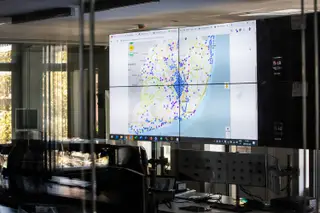The population of Lisbon doubles every day. In addition to its inhabitants, the city welcomes hundreds of thousands of people from neighbouring municipalities, who commute to work and spend a good part of their day in the capital. This is why those working at the city council in the area of mobility strive to meet the needs of the population travelling to and from and around Lisbon and not only to those of the city´s residents.

Francisca Ramalhosa, Municipal Director of Mobility and Transport at Lisbon City Council, found the time spent in the city with regard to mobility particularly challenging when she took office. “The context allowed us to roll up our sleeves and accept the challenges of the different audiences in relation to mobility,” she explains. She adds that a lot is being done in Lisbon and plenty more will be seen in two years´ time.
The city council is focusing its investment on Carris, where equipment is being purchased and more people are being hired. The aim is to increase the number of careers and the frequency of the same. “We are also expanding the number of bus kilometers with the launch of four new corridors, as a means of prioritising public transport,” she adds, while pointing out that solutions involving smaller vehicles already exist for traditional neighbourhoods.
SOFT MODES OF TRANSPORT IN VOGUE
Furthermore, soft modes of transport such as bicycles, scooters and shared electric motorcycles are gaining in popularity. “We work with a number of private operators, who are required to comply with the rules we define, and our role is to create answers to their needs,” says Francisca Ramalhosa. The operator in this area is EMEL with its Gira bicycles. The business, she says, is a success, and the company plans to open more stations and increase the number of bicycles in the near future.
Apart from public transport, and the soft modes of travelling around the city, there will always be people who opt for individual transport. They need to travel in and out of the city in the best possible conditions. This is why Lisbon City Council is investing heavily in technology in the area of traffic lights and traffic management,” reveals Francisca Ramalhosa.

Once concluded, the modernisation of traffic light controllers, a process that is currently under way, will allow the city council to acquire a new management system, which will enable traffic lights to be adapted to the traffic conditions at the time. This doesn´t happen today. In the event of an accident in congested areas, “Lisbon needs a system that enables us to recalculate and adapt the means of making traffic flow”, she explains.
SUSTAINABLE MOBILITY
The European Commission based its decision to award Lisbon the title of Green Capital of Europe 2020 on the investment in shared and non-pollutant mobility and the search for innovative solutions. However, while things are moving towards more sustainable and smarter mobility in the city centre, there is still a lot to be done in relation to the thousands of people entering and leaving Lisbon on a daily basis. “In addition to infrastructure such as peripheral park and ride facilities, we need to create digital tools designed to let us know what the best routes for getting from A to B are,” argues Francisca Ramalhosa. “We also need to update the interfaces for the different modes of public transport, designed for a reality that no longer exists. “Improving conditions for people wishing to travel by public transport remains one of the priorities in a city that is preparing itself for the ambitious target defined for Portugal in the 2050 Roadmap for Carbon Neutrality.
João Martins, an associate professor at the NOVA University of Lisbon School of Science and Technology, argues that “renewable sources are not a solution for everything”, and that “the major current challenge consists not only of reducing the consumption of energy, but above all through the more efficient use of the same”.
